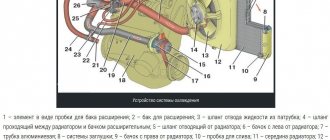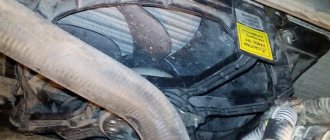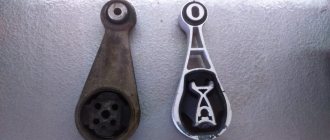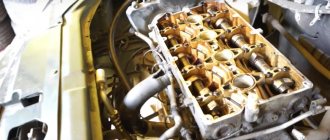Gets hot in traffic jams VERY MUCH! Up to 110C. What, where to look?
This is the situation.
A week ago I was driving around the city, the temperature did not rise above 95-100. Right now I noticed that the temperature is rising to the last extreme White scale. Sometimes it rolls a mm towards the red one (see picture). Carlson works, but spins for a very long time, try another minute. And the temperature, even when it is turned off, does not drop to the yellow stripe.
Thoughts are different, maybe the thermostat should be replaced? Maybe the Carlson sensor is on? Tell me, let's think about it.
The machine works from morning to evening, I wouldn’t want any problems. It's filled with antifreeze, I haven't changed it since I bought the car.
Just arrived, took fresh photos: Judge for yourself:
The moment the fan turned on (or was already working) I heard:
The moment when Carlson was still working:
The moment when Carlson stopped threshing:
The idea is this: Carlson is turned on through emergency mode, i.e. not from the coolant temperature sensor. Of course, I’ll replace it now, go to the North at night, and replace the thermostat somewhere.
Doesn't anyone really have any more thoughts?
Lada Priora Sedan 2007, 98 l. With. - breakdown
Cars for sale
Comments 50
To all PRIORA car owners, good day! I had such a situation that the car was warming up in traffic jams in hot weather at 30 degrees and above, in cool weather it rose to 27 to 95 and the fan came on and the temperature dropped to 92. And also when driving out onto the highway the temperature was 92, but as soon as we drove into the city the temperature rose to 120 degrees. I changed the pump, thermostat, radiator and expansion tank, but why I changed it there was a crack on the tank and there was no result, the car continued to heat up. After which I decided to remove the head, although there were no signs, it warmed up periodically for two days I drove without heating, one day the temperature rose and that’s it. The oil in the engines was clean, when the head was opened it showed that antifreeze had gone into the first and second cylinders, they discovered a micro crack in the head, that’s the reason. I had to do some capital work, the engine overheated.
Source
Priora warms up on the track
Good day! Not long ago I encountered several problems that, in my opinion, came from one another.
At the beginning of all troubles lay the following moment. One day the car began to behave strangely. First the power steering failed, which was very strange. After this, the car would not start and the battery was completely discharged. The generator is new, the battery is good. The problem was that the wire at the junction with the terminal burned through and fell off. I changed the terminal, stripped the wire, everything is fine. But the situation repeated itself several times.
I solved the problem by purchasing new wires and replacing both terminals going to the generator. Due to lack of experience, the wire was thrown past the stove and cooling system fan. The electricians fixed everything, but while driving to them, most likely the engine overheated at a traffic light. This is very inaccurate, why I think so, I will describe further.
Then everything was fine, but I began to notice that the coolant temperature on the highway began to tend to the upper limits, to 100-110 degrees even in the spring, which was not very good. After touching the hose to the radiator, I concluded that the thermostat was not working. Replaced it, boiled it - it really didn’t work. But the replacement didn't help much. The picture remained the same with some changes. The pipe to the radiator became hot only after stopping, opening the cap of the expansion tank and squeezing this pipe. At the same time, the temperature dropped precisely after opening the lid of the plant tank.
Most of the craftsmen unanimously argued that the matter was caused by a breakthrough of gases into the cooling system, the cylinder head was taken away, or there was a crack in it. It became scary. And basically all the masters spoke only this version. I took a break from the Internet and found several useful videos on YouTube. I carried out the final diagnostics using a condom, which, in the absence of gas breakthrough, should not inflate too much, but should remain approximately the same size. In my case, it was inflated. I also learned that in nature there is a special device that allows you to check whether there are gases in the cooling system, but in our city there were no such services in our city.
The second version, which I believed in more, was the pump. I heard in just one video that in 80% of cases the car gets hot on the highway precisely because of poor pump performance. Maybe the impeller is corroded, maybe something is faulty there. But all the experts unanimously said that there would be global overheating even in the city, and especially since I changed the pump about a year or two ago, everything should be fine with it. But in the city everything was fine with my temperature.
Since experienced people say that the cylinder head means the cylinder head. The master removed the head and said that there was a bad crimp at some points, and a couple of the cylinders seemed to be flooded. The gaskets were replaced and the head was put in place. But the result was approximately zero.
I decided to check my version and change the pump. The service center did the work, then they twirled it at my temple, saying that my pump was perfect, they didn’t understand why I even paid money for this useless operation.
I don’t understand car repair at all, I don’t have any education in this area and I don’t have a lot of experience either. But visually I already realized that there was something wrong with the pump. I turned the impeller and everything turned perfectly. I turn the pulley, lightly hold the impeller - only the shaft rotates, the impeller remains motionless in my hand.
This repair has already helped. Now the highway is stable at 90 degrees. All the specialists I contacted in Yaroslavl said that the pump could not be the cause. I’m not sure that it was necessary to go into the cylinder head at all and spend money on it.
In any case, I'm glad that the problem has been resolved one way or another. I also replaced the expansion tank at the beginning of all the problems, tried many expansion tank caps, since again the technicians suggested first dealing with the pressure in the system. I already bought everything I needed to flush the cooling system, but didn’t bother doing it.
The moral is this - if the engine overheats on the highway and there are no obvious signs of gases breaking through into the cooling system (smell in the expansion tank, failure of the cooling system pipes, a ball or condom rapidly inflates at the neck of the expansion tank), and there are no other problems with the cooling system (thermostat malfunction, fan malfunction, radiator malfunction and clogged, dirty engine cooling system, leaking cooling system, incorrect coolant filled, faulty expansion tank cap), then think about the pump. There are no external signs of this malfunction, except for a sharp increase in temperature (in my case on the highway) or there are sounds.
Source
Consequences of mild, moderate and severe overheating
The consequences and cost of repairs depend on the degree of overheating of the internal combustion engine. Timely maintenance of the car, monitoring the coolant level and temperature conditions when driving reduces the occurrence of overheating significantly.
Slight overheating of the internal combustion engine occurs when the engine operates at a temperature exceeding the temperature for 4-12 minutes. This mainly occurs when the thermostat or fan malfunctions, and the driver detects this in a timely manner and takes action.
In many cases, such a situation, if it occurs once, does not affect the condition of the engine, especially if it has a short mileage. The pistons often melt slightly; when the temperature rises significantly, even for a short time, dark-colored smoke appears from the muffler, and there is a feeling that the engine is constantly running under load.
Even after a single short-term overheating of the engine, it will subsequently begin to heat up more often due to changes in the pistons and the remaining melted metal in the cylinders.
The average degree of overheating of the internal combustion engine appears when the engine is running at extreme temperatures for at least 20 minutes. There are many reasons for this situation and they have all been described earlier.
The consequences of such overheating are already more tragic. In addition to the consequences characteristic of mild overheating, which manifest themselves to a greater extent, there are added skew of the cylinder head or the appearance of cracks in it, burnout of cylinder head gaskets, ejection of the valve seat, severe deformation of the pistons, destruction of the inter-ring partitions of the pistons, oil leakage from under all kinds of gaskets and seals .
Severe overheating of the internal combustion engine causes all sorts of very serious consequences. In this case, individual working units may survive or the engine can be thrown out.
The main consequences of excessive engine overheating:
The engine gets hot
Over the past month, I began to notice that the engine temperature was constantly within the range of 101 - 99 degrees
. Even on the highway.
Driving around the city has become uncomfortable - the cooling fan is constantly running, but the temperature does not drop below. In this case, both radiator pipes are hot. And everything would be fine, but - in traffic jams with the air conditioner on, the temperature needle stubbornly crawled towards the red zone, the on-board indicator gave values of 107 - 108 degrees. I had to urgently turn off the air conditioning and keep the idle speed at 2000 - 2200 rpm. I didn’t put off all this disgrace for a long time. I bought a new thermocouple for the thermostat. I took PRAMO 85 degrees. And today I started replacing it. It is best to change it on a cold engine to avoid getting burned. I changed it while it was hot. I removed the air filter and clamped the expansion tank pipe. And carefully unscrewed the three hex bolts (5).
One and a half to two liters of antifreeze spilled out. I replaced the thermoelement and gasket - the old one became wooden and cracked when disassembling the thermostat. By the way, the thermostat installed on the car turned out to be just right.
I put everything back together, replacing the clamps with new ones. Added antifreeze. I started it up, and when it warmed up to 86 degrees, the lower pipe began to heat up. I waited for the fan to turn on (I have it set to 101 degrees from the on-board vehicle). After turning off the fan (98 degrees), the temperature continued to decrease (to 93). This has never happened before!
I turned it off and added antifreeze to the required level. I started it again and waited for the fan to operate, checked that there were no leaks anywhere, and went off to test it, satisfied. In the city, the temperature did not rise above 94, the air conditioner was constantly running (+32 outside the window). In general concluded: the old thermoelement was a little wedged and did not open completely to a large circle
. Therefore, the fan partially cooled the engine.
While the antifreeze was draining, I changed the adsorber valve. With the old one, the error of incorrect air flow through the valve periodically came on.
Source
Malfunctions of the crankshaft position sensor
The on-board computer may send incorrect impulses to all vehicle systems.
Most often this happens if one of the sensors is faulty. Incorrect engine operation is often associated with a malfunction of the crankshaft position sensor. It needs to be removed for testing. The test is carried out with an ohmmeter. Readings should be between 550 and 750 ohms. If they are outside this range, then the sensor must be replaced as it is faulty. Usually, after installing a new element, the power plant begins to work normally.
If the on-board computer generated an error for this sensor, then after replacing it, remove the terminal with the minus sign from the battery. This will help clear the ECU memory of the fault record.
Source
Increased temperature Priora Station wagon 2011/Victory over the problem
Hi all. I will not deliberately delete all parts of this story, in case someone someday steps on the same rake as I did. And I hope he will get by with an easier solution...
In general, what has been done since the purchase for this reason: 1. In September, when I noticed that the machine turned on the fan and just turned it on indefinitely, I immediately replaced the thermostat with a Luzar
and antifreeze.
3. Here it is, spring. Long awaited. The temperature outside is closer to above zero. I was driving along the highway, the temperature was approximately 93-95, I didn’t have a BC yet, I was just getting my bearings from the instrument panel. It got tense.
4. I decided that I needed to replace the thermostat, in the store where I buy only Luzar
. Moreover, it’s already in a plastic case, but that’s not the point. Let's take it. Plus more antifreeze.
5. Something doesn't help. We drive around, watch, BC State x1 arrives, install it, the temperature outside is already above zero, the car is still warming up while driving.
6. I went to see a friend to sort things out. We took off the belt, it is normal, we need to look at the pump. We look, there is no play, but it spins very poorly, we change to Luzar Turbo
. I fell for the steep impeller.
8. To be honest, I’ve already lost the order of events, but I remember that after all this I bought another Luzar
.
9. It was all really hot, I didn’t know what to do. I remove the radiators, while releasing gas from the condenser. I wash everything in the bathroom with a shower and soak it. Past BZs have it all.
10. Can you imagine how much of my time I’ve already wasted? How much money? While everyone is having a blast on the weekend and watching, I’m in the garage. But there’s no point.
11. I have already scoured the entire Internet that I can, collected all the radiators and other tripe. I had to go to a friend for a service to change the front brakes, I also took the Luzar
.
12. We replaced everything, reassembled it, and at the same time changed my shoes for the summer. Everything seems great. But the temperature is the same. They shrugged. Well, maybe that’s really how it should be.
14. I buy a thermometer in a pharmacy up to 100g. and in a mug I boil the thermostats that I had before on the stove. My parents have already begun to suspect that I need a narcologist at a minimum.
15. All thermostats that were opened clearly at 85, and as they heat up, more and more. The gap is really different everywhere at maximum speed. 5 mm approximately, measured with hexagons of different sizes. Luzar
that apparently has nothing to do with it.
16. The system needs to be washed. Suddenly the channel became clogged. Suddenly, when they removed the head, they changed the pistons to 124, something is wrong there, suddenly the head wasn’t polished, suddenly the firmware for 124 pistons doesn’t roll, suddenly the mixture is poor... suddenly... suddenly...
17. Clean my system with lemon and distilled water. Yes, maybe something is wrong, but it was pretty crap there. I did a useful job in short. You've already brainstormed everything, but it didn't help at all. After the procedure I installed the very first, still metal, Luzar
, which opened clearly at 95 and the gap was about 6mm. Well, they are engineers, they know better.
18. That's it. kapets. We sit with Nikita-Guryanov and understand that the gasket is breaking through somewhere and pressurizing the gas, heating up the antifreeze.
20. I remember that, in addition to everything described, everything in the world changed. Lids, an expansion barrel that burst, temperature sensors, some even more than once, thrown all sorts of masses, etc., etc....
21. That's it, screw it. This is to remove the head. I call a friend and ask for the key to a luxurious, comfortable garage. I'll shoot the head shorter. Myself. What the hell to do.
23. After reading the advice from Drive2, I understand that either this is how it should be, whatever you wanted - it’s a VAZ, kill yourself, or the head is accelerating. We need to find an endoscope. Look into the cylinders, you will see there.
24. I’m going to look for an endoscope in the city. It is only available in the service.
25. I arrive, explain to the young guy what I want from him and what is happening to my car. He told me “This is normal, change the thermostat.” I explain to him that I have changed the thermostat 4 times already. Luzar
can't lie like that. And he answered me: “Change the thermostat. All my friends who were in Priora suffered with them. Read Drive2, they put some kind of foreign one there.” Okay, I didn’t believe it right away, but...
26. Evening. Because in my store where I buy spare parts only Luzar
, I decided to stop by a store that I don’t love with all my soul, but it’s personal.
27. I arrive, look at what is there, the seller, of course, is talking nonsense, but I agree and take what I need. Thermostat is Chinese Hofer, the price of this miracle is 380 rubles. Skeptical about it, I get into the car, go to my spare parts store, take clamps, pipes and go to a comfortable garage.
28. Here it is. victorious evening. I unscrew the protection, drain the liquid completely for the hundredth time, remove the thermostat completely, disassemble the pipes, even pull out the heater radiator, it is normal, there are no leaks. I clean everything, check it, make sure it’s sealed. The pipes are old, in basically excellent condition, they haven’t even leaked anywhere. It won’t be superfluous, since I got into this loop.
29. I am also skeptical about putting the thermostat in its place. I start it, warm it up, remove the plug, but it doesn’t come out. 81-87 gr. The on-board vehicle shows, but the stove does not hold the heat.
30. I leave the garage, find a hillock near the neighboring garage, lift my face, and accelerate. That's it, no air, fire. And the temperature is again over 90+. Well, I think it didn’t help again, go take your head off.
32. What a smile I had when I drove out onto the road and the temperature was 84-87 all the way. I was as happy as a child who had achieved his goal and received some cool toy. Hooray.
33. I went for a ride in the evening, checked everything, yes, indeed, this is a victory. Just when I was boiling Hofer on the stove with thermometers in my hands and nervously twitching my leg, my parents were already calling the orderlies. Hofer opened the thermostat a fraction of a mm already at 78-79 degrees and opened at 85 quite boldly and well. Approximately a little over 7 mm at the peak.
34. Today it was +22 outside the forest, really hot. I drove a lot, the temperature is stable at 87. I am very happy.
The only thing I'm not happy about is that Luzar
turned out to be such crap. I spent so much effort, time, and nerves. It’s so good that I listened to this bearded guy from the service station and didn’t go any further. I don’t know, maybe I have some unique case for this company and it’s not right for me. BUT, 4 pieces, thermostats, a bunch of sensors, other crap, and I’m generally silent about antifreeze. It burned wildly. I threw all of their products into the trash container in the morning, when I was cleaning up tons of accumulated garbage after all this. What I changed initially, at the beginning of the journey, failed in the end. I’m not going to throw mud at you, but this is a really unpleasant topic, very offensive.
Thanks to everyone who read, followed, and advised. Those who haven’t read and advised, thank you too. Special thanks to the guy from the service station, nitroplazma and Nikita-Guryanov for your patience. Thanks to Goshan for the comfortable office. I hope this is just the last such headache.
Source
Design of the Priora internal combustion engine cooling system
Below in the picture you can see a diagram of the engine cooling on a Priora with a description of its components.
The cooling system includes the following elements:
All these details seriously affect the operation of the SOD, namely its effectiveness. Failure or improper operation of one of the parts can lead to malfunctions in the operation of the internal combustion engine and its overheating.
Bad thermostat
In hot weather, this element can also affect engine overheating. If there is a malfunction of the thermostat, the engine begins to heat up longer, and while on the road it constantly increases its operating temperature. Therefore, if the engine heats up at speed, most likely the cause is the thermostat. A low-quality part may simply jam. As a result, the half-open element is unable to ensure normal heat exchange and circulation of coolant at high speed. The way out of the situation is similar to the first case - the faulty element must be replaced. By the way, many owners of domestic cars in the summer simply remove the thermostat and drive without it. The engine of such cars does not heat up throughout the hot season. Well, with the onset of autumn, motorists again install this element in its regular place.
Note that the engine does not always heat up due to the thermostat. Perhaps the reason for this may be the lack of coolant in the system (we'll talk about this a little later). Therefore, the thermostat is always tested for functionality before replacement.
Reasons why Priora overheats
There can be many reasons for overheating, but they are all of the same type and finding the cause of this illness is quite simple.
Cooling radiator
This part serves to cool the liquid, which, passing through the radiator, is cooled by a counter flow of air and then enters the engine, cooling it. When a radiator becomes dirty or damaged due to an impact, its tubes become bent, preventing the free flow of fluid through the system, thereby preventing the fluid from cooling to the required temperature. Due to this problem, overheating of the internal combustion engine is possible.
The problem can be solved by replacing the radiator with a new one, or by flushing it.
water pump
The water pump is used to help circulate coolant through the system. The pump is a part with a gear, shaft, housing, impeller and bearings. Quite often on a Priora it happens that the impeller on the pump breaks or turns, and this leads to the impossibility of antifreeze circulating through the system and, consequently, to overheating of the internal combustion engine.
The problem is solved by replacing the pump with a new one.
Thermostat
To limit engine cooling and maintain its optimal temperature, a special thermostat valve is used. It stops the circulation of fluid through the radiator, thereby heating the engine to operating temperature; as soon as the optimal temperature is reached, the thermostat opens and allows fluid to flow through the cooling radiator.
It happens that the thermostat gets stuck in the closed position and this leads to overheating of the motor. It is quite simple to determine this malfunction; you just need to touch the lower radiator pipe; it should be hot; if it is colder than all the others, it means that the thermostat is jammed and must be replaced.
Cooling Fan
To cool the engine of a car sitting in a traffic jam, a special fan is used, which simulates the flow of air encountered and cools the radiator. If this part fails, then there will be no cooling of the engine in the plug, which will lead to overheating of the engine.
If the engine cooling fan does not turn on, you need to check the temperature sensor, fuse and power connector.
Engine pipes
After any repairs, some pipes may sometimes become bent, which will lead to the cessation of fluid circulation through the system and overheating of the internal combustion engine. If the Priora is heating up, then it is necessary to check the pipes for integrity and compression.
Replacing elements
Structurally, the Lada Priora engine cooling system has a simple design. Therefore, we will consider replacing only individual components, with which certain difficulties are possible, especially for beginners.
Replacing the cooling system radiator
This unit on cars rarely changes. Typically, this procedure is necessary when a leak occurs that cannot be eliminated. Its service life can be 10 years or more. Cases when replacing the radiator are simply necessary are as follows:
- unprofessional repairs in the engine compartment, during which the radiator cooler tubes were damaged;
- damage as a result of an accident;
- Increased pressure in the system caused the leak.
Removing the old and installing a new radiator, as well as replacing antifreeze on a Priora with air conditioning, is somewhat more difficult. Therefore, to save time and nerves, it is better to entrust this matter to professionals. If there is no air conditioning, you can change the radiator yourself.
- Unscrew the drain plug at the bottom of the radiator and drain the antifreeze into a suitable container.
- Show all the pipes that go to the radiator.
- Unscrew the fastening nut from the top and right side.
- The fan can be left on the radiator; it can be removed at any time.
- Move the radiator towards the engine and lift it up, thereby removing it from the engine compartment.
If the fan remains on the radiator, you need to disconnect the terminal from it. Installation of a new radiator is carried out in the reverse order of removal. If necessary, you can change the antifreeze.
Replacing the thermostat
Another important element of the cooling system, which can be changed independently. This is done as follows.
- The car needs to be placed on a viewing hole, or at least hang the front part so that it is possible to crawl up from below.
- Unscrew the cap of the expansion tank.
- Remove the engine protection (if there is one) and unscrew the drain plug on the cylinder block from below (not visible from above).
- Before unscrewing the drain nut, you need to place a suitable container under it. Then you can unscrew the plug and drain the coolant. Work is carried out on a cooled engine, otherwise there is a high risk of getting burns.
- Under the air filter to the right of the cylinder block you need to find the thermostat and, by loosening the clamp nuts, remove the pipes from it.
- Using a hexagon, unscrew the thermostat fasteners and remove it.
Before installing a new thermostat, you should pay attention to the rubber seal where it is attached to the block. To improve the tightness, it is necessary to coat it with a silicone gasket sealant. Next, all that remains is to install a new thermostat, connect all the pipes and fill in the coolant. After this, you need to start the engine and warm it up to 90 degrees, then inspect the thermostat and pipes for leaks. If necessary, you need to add antifreeze and remove the air lock, if any.
After replacing the thermostat, all that remains is to check its functionality. If the thermostat is working properly, the lower radiator hose should be cool when starting and running a cold engine. You need to let the engine run until it reaches operating temperature.
After the pointer on the instrument panel shows 90 degrees, you need to touch the lower pipe again. It should heat up smoothly. If this does not happen, the thermostat is faulty.











